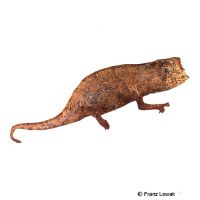Minute Leaf Chameleon (Brookesia minima)
| Minute Leaf Chameleon Brookesia minima | |
|---|---|
| Name | Minute Leaf Chameleon |
| Name Lat. | Brookesia minima |
| Family | Chameleons |
| Family lat. | Chamaeleonidae |
| Order | Scaled Reptiles |
| Order lat. | Squamata |
| Origin | Madagascar |
| Habitat | Rainforests |
| Diet | Insects |
| Humidity | 60-90 % |
| Behavior | ♂ territorial |
| Keeping | Individual, pair |
| Care Level | Experts only |
| Reproduction | Oviparous |
| Housing | Humid terrarium |
| Life Span | 3-4 years |
| Protection | CITES Appendix II; EU Annex B |
| Metric Units | |
| Size | 4 cm |
| Temperature | 18-22 °C |
| Temperature Local | 25-28 °C |
| Housing Size | 30 x 30 x 40 cm |
| US Units | |
| Size | 1.6" |
| Temperature | 64-72 °F |
| Temperature Local | 77-82 °F |
| Housing Size | 10" x 10" x 15" |
Distribution and habitat
The ground-dwelling, diurnal Nosy-Be stub-tailed chameleon occurs in some locations in northeastern Madagascar and the offshore island of Nosy-Be. This smallest known chameleon lives in the fallen leaves of mid-elevation rainforests.
Maintenance
Minimum dimensions for the terrarium, according to the size and number of animals:
| One animal | 4KRL x 4KRL x 2,5KRL (L x W x H) |
Head-torso length (KRL) is measured on the largest animal. For pair keeping, increase the floor space by 20%. A terrarium of e.g. L 30 x W 30 x H 40 cm is recommended, which should be placed in a quiet and vibration-free place.
You need a well ventilated terrarium, structured with some branched climbing branches, plants as privacy screen, structured back and side walls (e.g. cork covering), a loose and moisture retaining substrate covered with foliage, e.g. forest soil-peat mixture, as well as a small water container or a dripper. The substrate should always be kept slightly moist (no waterlogging). Several times a day the inside of the terrarium should be finely sprayed with water (humidity), but a rain or mist system is better.
| Temp. day: 18-22 °C | Temp. night: 15-20 °C | Temp. local: up to 28 °C | Humidity: 60-90 |
The lighting duration must be 10-14 hrs depending on the season. They need a high light intensity. Special lamps that produce the necessary heat and UV light are ideal. Daily UV irradiation is essential.
Diet
The food supply consists of small live insects, such as fruit flies, aphids, springtails and micro crickets. Sometimes the change to commercial ready-made food for insectivorous reptiles, which must be offered with tweezers, is successful. It is important to add minerals and vitamins regularly (dusting the food). Since water is almost only absorbed in drop form from leaves or furnishings, a dropper is recommended, alternatively they can be watered daily from a pipette
A regular and varied diet promotes health and prevents deficiency symptoms.
Reproduction and breeding
Adult females are slightly larger than males
For mating, the female carries the male on her back for several days. The female buries her eggs (2 pieces) in the soft, moist substrate. The incubation period is 30-70 days at a temperature of 18-22 °C
Life expectancy can be 3-4 years.
Species protection
The animal population must be reported to the competent authority in writing immediately after the start of keeping. Your pet store will be happy to provide you with further information.
Protection of species: WA Appendix II; EU Appendix B. The proof of purchase is the required proof of origin for the animal. Please keep it safe!
Important
They require a small sunny spot. When threatened, they play dead and resemble a leaf. Adult males behave very territorial among themselves.
For the resting phase, the lighting duration is shortened by 2-3 hours for about two months.
With fruit and honey water as food for the feeders, their quality can be upgraded.
The terrarium must have good ventilation without drafts and meet the species-specific needs. Measuring devices such as thermometers, hygrometers, etc. are necessary. The lighting has to correspond to the species-specific day-night rhythm and has to be placed in such a way that the animals cannot injure themselves. The terrarium should be locked in such a way that neither unauthorized persons can open it nor the animals can escape. Contamination must be removed regularly
Further literature can be found in your pet store.
References
Text: Christian Sänger; Image: Franz Lowak
Source: BMELV (1997): Mindestanforderungen an die Haltung von Reptilien; ENGELMANN (2006): Zootierhaltung - Tiere in menschlicher Obhut: Reptilien und Amphibien, Harri Deutsch Verlag
- Gemäß § 21 Abs. 5 Tierschutzgesetz idgF
